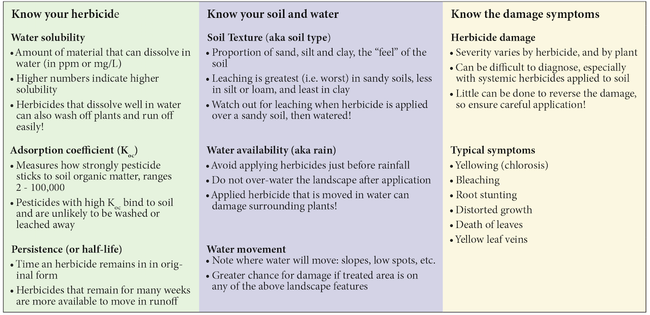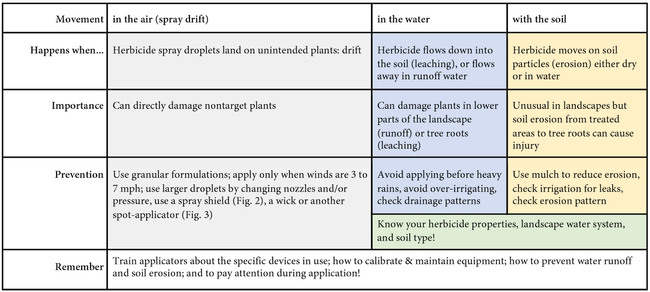[From the May 2017 issue of the UC IPM Green Bulletin]
![Fig 1. Severe case of Imprelis herbicide injury to trees. [P. Landschoot, Penn State Extension] Fig 1. Severe case of Imprelis herbicide injury to trees. [P. Landschoot, Penn State Extension]](http://ucanr.edu/blogs/UCIPMurbanpests/blogfiles/44239.jpg)
This nightmare situation occurred several years ago on coniferous trees in many Midwestern landscapes where a presumably “safe” herbicide labeled for use in turf, Imprelis, had been used (aminocyclopyrachlor; never registered in California (Fig. 1).
As landscapes become more complex – combining trees, shrubs, grasses, and forbs – and as their management goals widen to include water conservation, carbon storage, and even food production, landscape managers need to be vigilant about both the previously-unknown negative effects of herbicides as well as known-but-avoidable application mistakes, especially around mature trees – the most valuable components of our landscapes.
General concepts about herbicide use in landscapes
It is generally accepted that herbicides can be a part of an economical weed management program and can even be indispensable in some situations: on steep slopes or areas that are otherwise inaccessible to hand-weeding or mowing, for suppression of re-sprouting in woody weeds, for allergenic weed species, fuel reduction, etc.
In many landscapes, weed suppression by mulching and mowing can be successful as primary management methods. In addition, weed control around older established trees is usually not as important as it is around younger ones whose establishment might be compromised by the competing weeds.
Because herbicides can damage or kill susceptible plants, regardless of whether they are weeds or desired, they have at least some potential to damage trees. The risks in using herbicides around trees, both mature and establishing, should be carefully considered. We discuss below the issues and techniques that may help to minimize the chances of damage.
Before you use an herbicide:
- Read the label! Ensure that your chosen herbicide includes on its label both the weed species and site type where you intend to apply. Keep in mind that this is just the starting point. For example, Imprelis was used according to label guidelines on turf, but nearby trees were nevertheless affected. Understand the risks of herbicide applications “moving around” the landscape (see below).
- Check the site for environmentally sensitive areas: ponds, wetlands, historical plantings, etc. and reconsider your weed management options.
- Check the soil type and determine if there will be issues with runoff or leaching (see below). Also check the label for any guidelines or restrictions associated with soil types. Apply the rate most appropriate for your site. Herbicide movement in the landscape can lead to serious damage to trees.
Avoid spray drift, runoff, and leaching
These are the three primary mechanisms by which herbicides “get around” the landscape. Volatilization is the movement of pesticide vapors through the air, and some herbicides have been shown to volatize and cause injury in closed structures such as greenhouses. However, volatilization is generally not considered to be a problem for most herbicides outdoors unless air temperature during application is over 90°F (in which case you may also be in violation of other health and safety regulations).
To minimize chances of problems, understand these important factors:
Special situations: look out for possible problems in these situations:
Trees in turf: Herbicides intended for turf can impact trees, especially trees with
- shallow roots (systemic uptake, e.g. trichlopyr), or roots extending under pathways or other areas where nonselective herbicides are applied
- grafting roots (i.e., roots naturally connected underground) where treating one tree may damage the adjacent trees of the same species
- low-hanging branches (impacted by herbicide drift from turf)
- with thin bark (esp. glyphosate, which can penetrate if drifted onto thin bark)
Shared equipment: Application equipment (tanks, sprayers, etc.) that is used for herbicides should ideally not be used for anything else, and should be clearly marked. If you borrow spray equipment, do you know if it has been used for herbicides?
“The Unknown unknowns”: Finally, keep in mind that our understanding of how herbicides can affect trees is incomplete, especially for new products like Imprelis, mentioned at the beginning of this article, but also for unusual landscape situations.
In other words, unhappy surprises are possible whenever herbicides are used in complex landscapes. If you are unwilling to risk damage to your landscape trees, consider carefully
- your need for an herbicide (could other management methods suffice?)
- your understanding of the herbicide action and movement
- your confidence in using the proper application technique
For more information about managing and identifying weeds, see the UC IPM Pest Notes: Weed Management in Landscapes and the Weed Photo Gallery.
Additional information about Imprelis and other herbicide injury to trees can be found at http://extension.psu.edu/plants/green-industry/news/2011/some-observations-on-imprelis-injury-to-trees
Always read and carefully follow all precautions and safety instructions provided on the pesticide container label, as well as any other regulations regarding the use of pesticides. Not following label directions, even if they conflict with information provided herein, is a violation of state and federal law. No endorsements of named products are intended, nor is criticism implied of products not mentioned.
![Fig 2. A covered boom sprayer application on turf. [S. Paisley] Fig 2. A covered boom sprayer application on turf. [S. Paisley]](http://ucanr.edu/blogs/UCIPMurbanpests/blogfiles/44246.jpg)
Author - Interim County Director; Bay Area Environmental Horticulture and Urban Forestry Advisor

![Fig 3. Tools for reducing herbicide drift or movement (L-R): wick applicator; shielded spot-sprayer; roller applicator. [C. Wilen] Fig 3. Tools for reducing herbicide drift or movement (L-R): wick applicator; shielded spot-sprayer; roller applicator. [C. Wilen]](http://ucanr.edu/blogs/UCIPMurbanpests/blogfiles/44245.jpg)